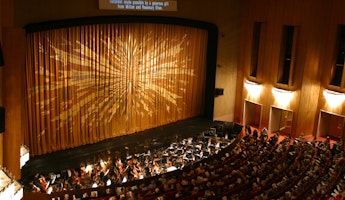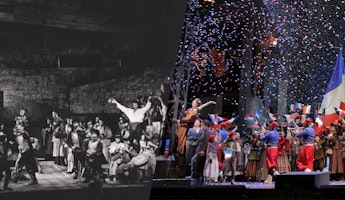Blog
May 23, 2024
The Many Endings of "Turandot"
When an artist dies before finishing a piece, an eternal argument takes place as to what the “true” ending is or should be. This is most certainly the case with Turandot, since the Giacomo Puccini only wrote up to the death of the character Liu before he tragically passed away. This meant much of the ending, including the duet between the love interests, was left unfinished. Before his death Puccini had created numerous pages of melodic fragments he had created for the scene. This led to composer Franco Alfano stepping in to write an ending for Turandot for the opera’s world premiere production in 1926. Knowing that his death was imminent, Puccini wanted a different composer, Riccardo Zandonai, to take over and do the honors but Alfano was chosen instead. While Alfano’s creation remains the ending most performed to this day (and is the one we’re currently presenting on stage,) other composers over the decades have offered their own endings. With Turandot on our main stage, we want to look at some of the endings that composers have offered throughout the years to see if there is an answer to the puzzle that is Turandot’s ending.
Franco Alfano
While Alfano’s ending remains the “standard” one most often heard, what we hear today isn’t what he originally came up with. The conductor of Turandot’s premiere, the legendary Arturo Toscanini, thought that Alfano’s take on the grand duet was inadequate compared what he claimed Puccini had played for him before the composer’s death. Toscanini brutally cut 109 bars of music, over a third of Alfano's score, before allowing the finale to be used. The resulting version, often called “Alfano II,” is the one most opera lovers know. Some opera companies have even gone further than Toscanini, cutting out Turandot’s aria “Del primo piano” from her confrontation with Calaf. Alfano’s full, uncut ending (“Alfano I”) wouldn’t be played until a 1982 performance by the Chelsea Opera Group, 58 years after the opera’s premiere. The full version has also been uploaded to YouTube where you can listen by clicking here.
Luciano Berio
Italian composer Luciano Berio (1925-2003) is best known for his experimental and electronic music, so it may seem strange that he would offer his own spin to Turandot. Yet he was commissioned to do so in 2001 by Puccini’s own publisher, Casa Ricordi. In Berio’s ending, he omitted any written text that Puccini hadn’t set in his musical sketches, including the final chorus set to the famous melody of “Nessun dorma.” While you'd think that would make Berio's ending shorter than Alfano’s, it’s four minutes longer. This was due to the inclusion of orchestral fantasias, specifically one following the Calaf and Turandot duet. With the Alfano version so widely performed, Berio’s ending was described as a “calculated risk” by Italian newspaper Il Giornale. But it seems to be risk that paid off as those who have seen it have lauded it with The Guardian stating it was “the ending it deserves.” Berio’s ending was first performed in a January 2002 concert of the third act of Turandot in Gran Canaria, Spain. But just a few months later, LA Opera had the distinction of presenting Berio’s ending for its first inclusion in a fully staged production of Turandot. Listen to Berio’s ending by clicking here.
Hao Weiya
Moving away from Western composers, we now go to China. In 2007, the Beijing National Center for Performing Arts opened, and for their inaugural season they decided to stage Turandot. But they decided that they wanted a new ending for the opera, so they commissioned Chinese composer Hao Weiya. At the time, Hao was studying opera in Italy and had the chance to consult the Puccini Foundation in Italy about his new ending.
Changes in Hao’s version include a new aria for Princess Turandot which aimed to give a more in-depth reason as to why she falls in love with Calaf. The “Nessun dorma” choral reprise was also replaced with the traditional Chinese folk song “Jasmine Flower” which Puccini used throughout the opera as a motif for Princess Turandot. Hao’s new ending saw almost unanimous approval in China, with a reviewer calling it “an extremely significant artistic feat.” But it didn’t get as positive a reception in the West. While Western critics praised the young composer’s ambition, they found his ending to be incoherent and too far from what Puccini would have written for the ending. Despite the mixed reception, it’s still worth giving this ending a listen to see what you think of it. As a plus, there is a video recording of the ending to go along with it, click here to watch.
Christopher Tin and Susan Soon He Stanton
The most recent take on Turandot’s ending, premiering earlier this month, has been given to us by Grammy Award-winning composer Christopher Tin for Washington National Opera. This ending is particularly interesting as Tin collaborated with playwright and screenwriter Susan Soon He Stanton to offer an entirely new ending. Just like with Hao’s version, Tin and Stanton wanted to create more motivation for Turandot to fall in love with Calaf. They also wanted to break down Calaf’s brashness and show a more intimate and gentle side to his character. An example of this is the reprise of “Nessun dorma,” which now appears when Calaf reveals his name to Turandot in a moment of vulnerability. This isn’t the only familiar piece of music though; the executioner's motif that the opera starts with comes back several times but with Tin adding his own variations on it. Since the production is so recent there isn’t recording out for it yet, but Tin did do a series on YouTube breaking down his approach which you can watch here. The initial reviews of Tin's new ending have been very positive, but only time will tell if it catches on. But one thing seems clear: Tin won’t be the last composer to take on the riddle that is Turandot’s ending.
To see what LA Opera's upcoming shows are, click here.








/03-cosi/_dsc0996_pr.jpg?format=auto&fit=crop&w=345&h=200&auto=format)



















